Choosing devices for the heating system of a private house or apartment, the owners often fall into a deadlock situation and are lost, facing a huge selection of devices. After all, the correctly chosen elements of the heating system are not only a pledge of its long-term operation, but also the maximum heat transfer.
Panel steel radiators of heating - the invention of the end of the last century, which was promoted by production technologies steel sheets, welding, painting in an attempt to create heating radiators that will have higher characteristics than cast-iron batteries.
In the production of panel steel radiators for heating there is nothing complicated. Originally, panels of 1.25 mm thick steel sheets are stamped. At the same time, steel convectors of the P-shaped form 0.3-0.5 mm are manufactured. Ready-made panels are welded by roller welding, and convectors are already welded to them. Painting occurs at the very end of the product.
heating has hundreds or even thousands of items, require huge storage space, which only large corporations can afford. In addition, the organizations of the dealer and distribution network require substantial financial, material and human resources.
Advantages and disadvantages
Any product, regardless of its purpose, has advantages and disadvantages that are learned in comparison. Steel radiators, in contrast, have an integral structure that can have a number of advantages over another panel type, but there are also drawbacks.
Benefits:
- Holistic battery design
The panel radiator after the purchase is completely ready for operation, and it only needs to be connected to the pipes. As in other radiators, you do not need to add or subtract sections. When buying it is necessary to choose the right panel size and all. The product requires only to hang it on the wall, and everything else, up to the connection to the pipes of the heating system, can be done later. Also this advantage - integrity - becomes a drawback: in case of leakage, you can not replace only the section, as in the remaining batteries, but you will have to change the entire panel.
- Aesthetics
Many note that panel type batteries are better than modern housing, but it's a matter of everyone's taste. If you paint the product under the color of the room or curtains, then the panel radiator will become generally unobtrusive. Quite a lot of steel panel radiators are produced with the lower type, which allows you to hide the pipes.
- High heat dissipation
Possessing very high thermal conductivity, steel becomes an excellent material for choosing radiators with optimum technical characteristics. And the presence of convectors makes steel radiators for heating in general ideal in heat transfer.
- Saving
Not everyone can use a high-budget variant of the heating system for a private house, and in that case steel panel radiators - an excellent solution. They keep in themselves a small amount of coolant, giving its heat to the premises as much as possible. Low inertia in conjunction with the radiator thermostat allows saving up to 40% of energy carriers.
Disadvantages:
- Corrosive
In case of non-observance of operating conditions, for example, work with a poor-quality coolant, steel panel radiators can quickly enough. The presence of air in the system, the pH value is not appropriate, the annual descents of the coolant - in this mode the radiators will not last for a long time.
- Low resistance to water hammers
Hydrohammers do not happen in closed heating systems in private houses, but only in open-housing networks. But for safety, if the batteries are installed in the apartment, it is worthwhile to secure the devices with some kind of extinguishing device. For example, pressure reducer.
- Sensitive to transportation
Any, even a minor steel panel, can lead to breakage and, as a result, leaks, which will lead to the complete unsuitable operation of the entire battery.
Performance and types
Basically panel radiators have the following specifications:
- working pressure - up to 10 bar;
- test pressure - 13 bar;
- the temperature of the coolant is up to 110 o C.
Panel radiators are divided into the following types:
- T 10 - single-row, without convector and facings;
- T 11 - single-row with one convector, without an upper grate;
- T 20 - double row, without convector, with air outlet grate;
- T 21 - double-row, with one convector fins and with a closed casing;
- T 22 - double-row with two convector fins and a closed casing;
- T 30 - three-row, without convector, on top is covered with a grate;
- T 33 - three-row with three convectors and a closed casing.
Types 10 and 11, without convection, are capable of heat dissipation solely by heating the air.
Flat or stamped panels, measuring in height - 200-900 mm, length - 400-3000 mm.
Vogel Nut - are the only manufacturers of vertical heating products with a width of 500-600 mm and a height of up to 2.6 m, types 10, 20K.
There are two types: side and bottom, with presetting the thermostatic valve.
The main differences between types 11, 22 and 33
Convector - steel "coil", located between the panels of the heating device, designed to warm up the radiator of the air, passing through the canals, had time to warm up.
The warmer the air, the easier it is. Its speed of exit from the radiator increases, and if a correctly made radiator is brought up from above, you will feel the movement of air, as if a fan is driving it from inside. For example, the battery Type 22 has two convectors. 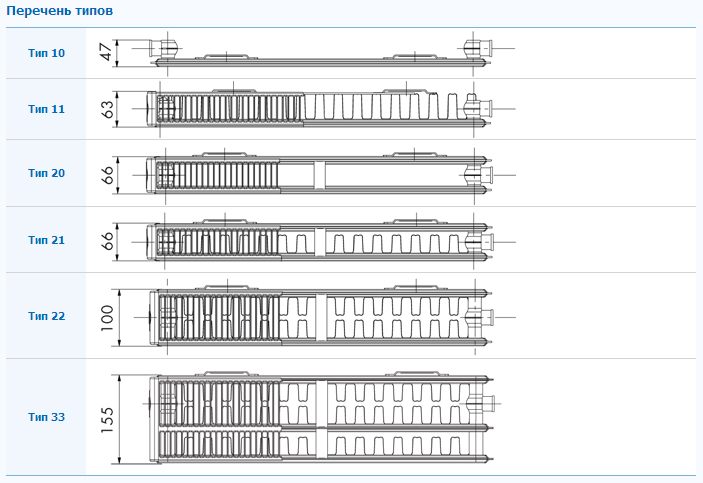
According to international standards, the designation of the type of heating device (for example, Type 22) - its technical characteristics: the first figure - the number of steel panels, and the second - the number of convectors. Type 11 has one panel and one convector, type 22 has two panels and two convectors, while Type 33 has three panels and three convectors respectively.
Type 22 with two panels and two convectors, fins and a closed casing is the most popular and sold out. Since Type 22 is perceived by the consumer as a golden mean and with an optimal level of the price / quality ratio.
There are also models VK 11, VK 22, VK 33, which differ in the thickness of the product and capacity, but the names correspond to the decoding of types 11, 22 and 33.
Proper operation and selection of the battery for the appropriate heating system will help to last longer.
In one of our articles devoted to aluminum radiators, we noted that in the EU countries practically do not produce heating devices from this material (the exception is only Italy). Of course, the question may arise: why? It's time to respond to it too: because Europeans prefer steel batteries. In this article we will try to figure out what they are better at and where they can be used in our conditions.
Steel panel radiators
All possible types of steel radiators, depending on the method of their production, can be divided into four groups:
- sectional;
- panel;
- tubular;
- lamellar.
The topic of our review will be panel radiators, as the most common, high-quality and not very expensive heating appliances.
The panel radiator is a flat rectangular panel (this was to be expected from the name), welded from thin-walled steel and having vertical channels for the flow of coolant in front and special ribs of U-shape at the rear. The purpose of the additional ribs is quite obvious: they increase the contact area of the enclosure with the ambient air and, therefore, allow better use of the thermal power for heating.
This design allows us to note the first advantage of panel radiators over aluminum: a thin flat housing and the absence of connecting elements between the sections.
This type of organization of the passage of the coolant is more reliable: every extra connection is always a possibility of leaks.
Varieties of steel radiators
Panel radiators are available in different versions. The main differences are what parts and how many are installed in them. There can be up to three panels in depth and up to three rows of fins (convectors). Each type of radiator has its own designation, consisting of two digits: the first digit - the number of panels, the second - the number of convectors. For example, a radiator, in which two flat panels contain laminated structures in two rows, will be of type 22. This is the most common version of a steel battery at the moment.
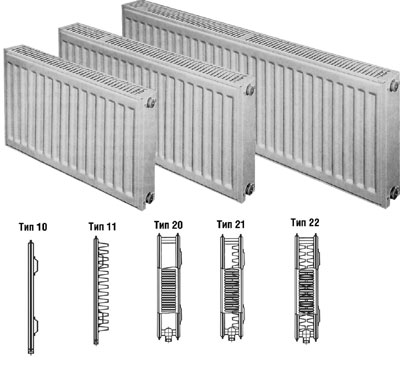
Often the type of battery is contained in its name, for example, RSV2-1 is a two-pane single-row radiator.
Another design feature is what connection schemes can be used with this or that device. Steel radiators can be connected to the bottom or side wiring, with each model designed for any one method.
Heat carrier
The main hydrodynamic characteristics of most panel radiators are approximately the same:
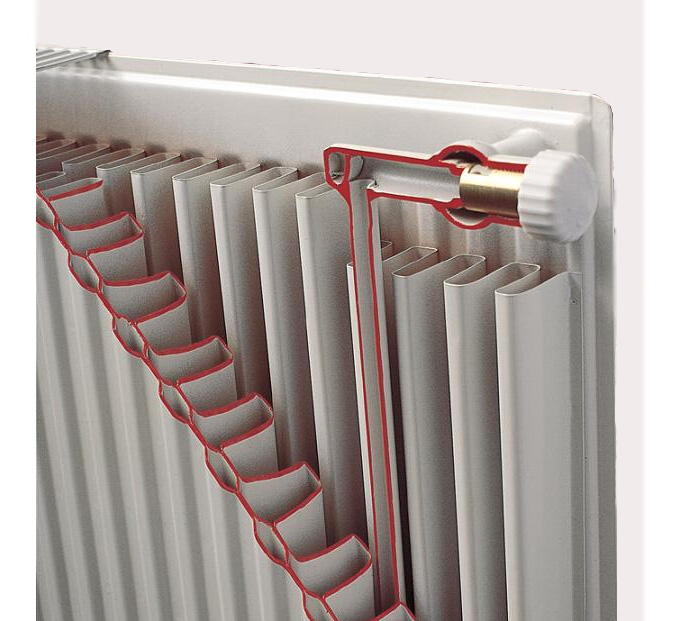
These parameters clearly do not allow us to recommend steel batteries for use in central heating networks. As you know, the working pressure in such a network should not exceed 9 atmospheres, but with water hammers, which often happen in our homes due to incorrect start-up of the system, it can significantly exceed the maximum load. So it's better not to risk this, the price of the issue when the battery is broken can significantly exceed the size of the savings when buying.
This conclusion is confirmed by some technical issues related to the quality of the coolant in utility networks. Therefore, further, describing this type of heating devices, we will assume that it is used exclusively in an autonomous system.
Dimensions and power
Steel panel radiators have a very attractive design, and the presence of numerous modifications in size allows you to choose the right model for any interior and existing niche. The elegant flat case can have a height of 20 to 90 mm, and the length is from 40 cm to 3 meters.
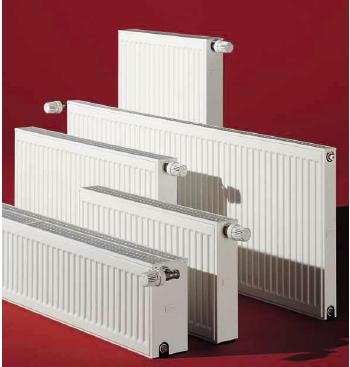
The thermal power of this device depends on its size and the number of panels. Given the excellent thermal conductivity of steel and a huge choice of housing dimensions, it can be said with certainty that such a radiator can heat almost any room.
Corrosion and service life
As you know, aluminum radiators are very sensitive to the composition of the coolant. How much better (or worse) are the affairs of their steel brethren?
Things are a little better, but far from perfect. Steel batteries do not react with copper elements of the heating system, but they can still be corroded if they are in the summer without a coolant.
This is another reason why they can not be used in multi-storey houses, where in the period of prevention the coolant merges.
Corrosion is also facilitated by small stones, pieces of scale and other abrasive impurities that are always present in the utility network. Whatever dyes or protective compounds used by manufacturers, practice shows that they serve one to two seasons.
Conditions for the use of panel radiators
So, let's draw some conclusions. Panel radiator is not suitable for a city apartment because of:
- low working pressure;
- predisposition to corrosion when draining the coolant;
- abrasive wear.
In a private house where the characteristics of the coolant are completely controlled, there are no contra-indications to the installation of steel radiators, their use is justified.

Let's recall that we came to similar conclusions when we considered another type of heating radiators - aluminum ones. However, they are corroded irrespective of whether the coolant is drained from the system or not; here, a violation of its acid composition is sufficient. On this indicator steel radiators are much better.
Price list
Price - another important advantage of panel radiators. It is noticeably lower than that of their aluminum counterparts. About what technical characteristics affect the cost, and how much the price of a steel device is lower than aluminum, we will see further.
Manufacturers
Below we will describe the most popular brands of steel panel radiators and give their average cost. In order to confirm the thesis that this type of heating battery is better than aluminum products, each time we will indicate how much the price of a steel battery is lower.
The main difficulty in this study is the selection of an analog for comparison. The main criterion here will be power and, if possible, overall dimensions.
Kermi
The main advantage of leading European manufacturers is the unique quality standards. German radiators Kermi - another confirmation of this. All Kermi batteries are based on proprietary technology, which provides higher efficiency and heating rate compared to competitors.
The Kermi radiator with a power of 2 kW (2123 W) with an inter-axial distance of 500 mm is retailed at 4100 rubles. The price of a similar aluminum device Global, (12 sections, capacity 2160 W) will be 4800 rubles. A video about Kermi's products is shown below:
Purmo
Finnish Purmo batteries are also an example of high-quality products manufactured on modern equipment in accordance with international standards ISO 9001. The guarantee for all products of this company is 10 years.
The radiator, similar to the radiator, containing two panels and plate convectors between them (ie type 22), with a capacity of 2,043 W, can be bought for 3,800 rubles.
Korado
Czech company that produces good steel radiators of the brand RADIK. The price they have about the same as that of the Finnish, the radiator for 2011 W worth 3900 rubles.
Copa

Copa radiators are manufactured in Turkey, although the office of this company is located in Germany. They have good heat dissipation, elegant design and quite decent quality.
The price of Turkish appliances is usually 20-25% lower than that of Europeans. The considered modification can be bought for 3300 rbl.
Conrad
We decided to finish our survey with a Russian-made product. Completely competitive radiators Konrad are designed for pressure up to 10 atmospheres and are positioned as appliances for heating multi-storey public buildings. The price is quite comparable with Turkish products - an analog of the well-known radiator RSV2-1 costs 3200 rubles.
We reviewed the characteristics, prices and major manufacturers of steel radiators. Which of them is better - to solve, of course, to you, we also tried to give the most objective information for the selection.
Rating: 666
The steel type of heating devices is becoming more popular every day in the 21st century. Basically, all the owners, cottages and individual projects install steel radiators.
Moreover, radiators made of steel for heating are a great solution for anyone who needs to build suburban real estate or change the heating system. The choice in favor of such heating systems is explained by the fact that their cost is comparatively cheap with respect to aluminum appliances, and they also have high heat supply criteria.
Most people ask themselves before installation how correctly, what is the main task in their choice? In today's world, there is a wide range of such systems. This is fine, as there is diversity in the choice, but this variety causes a feeling of uncertainty in the buyer. After all, most of these products are made by many manufacturers, differ in design, color scheme and other special categories.
Steel radiator types are now recognized as the most popular type among heating structures,
Steel radiators are a device for warming and warming apartments and houses, the equipment has a pair of stainless steel sheets welded together, having a water space, or a place for water. Batteries made of steel should not be put in places with a damp temperature, in bathrooms and bathrooms this equipment can not be mounted, as it will deteriorate.
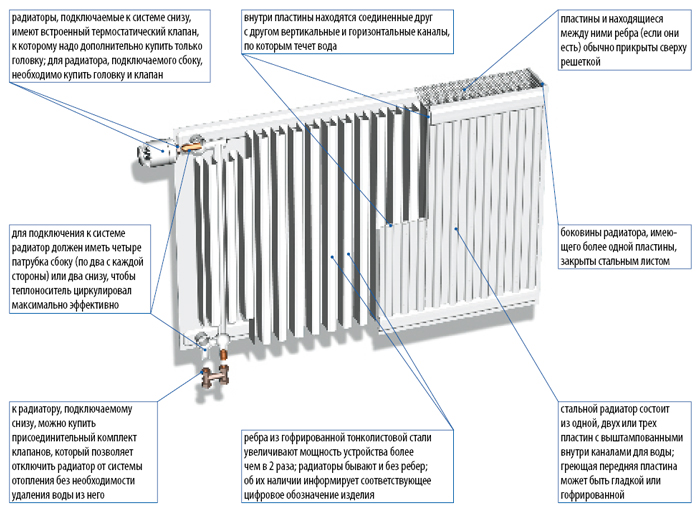
Device steel radiator
- for the production of such heating, high-quality metal and hard metals are used, which can give resistance to various shocks and loads. Such equipment is most suitable for private building plans, the service life in this case is increasing, as in individual buildings there are fewer stops and loads than in multi-storey buildings;
- simple techniques and techniques are applied, thanks to this the price for such products is optimal, which allows you to purchase any kind of your choice, which is suitable for a variety of types of buildings;
- the possession of stability to various attacks, because welding is open, without different chemicals, so do not be afraid of hydraulic loads;
the outer shell is the main distinguishing feature of such batteries, since iron can be painted in a different color range, which is sold in stores, can be sealed by sections, thanks to steel can heat the building of different scales; - universal tool, can be mounted on any fasteners, however they are included in the kit, therefore this equipment can be mounted quickly and clearly.
All the advantages of a steel radiator:
- due to design characteristics, the service life is practically eternal, the possession of a strong resistance to various injuries, the size of 2 cm;
- you can install such heating equipment manually yourself, this kind of work does not require unique skills and skills, it's enough to simply install everything on an existing template or on the manufacturer's website;
- have a unique design, and will fit into a variety of designer interiors.

Original design with steel batteries
All the disadvantages of steel radiators for the heating system of the house and apartment:
- the main minus of batteries from steel is instability at a damp temperature, after all in that case systems are spoiled and even in some cases are not subject to repair, and also there is a corrosion. Also, some of their partial terrain in no case should not be kept without water, because they will deteriorate;
- unique strong susceptibility to chemical abutments on welded seams;
- poor-quality paintwork leads to peeling and the original appearance of the batteries is lost for 3 years.
Knowing all the shortcomings of this steel equipment, it still becomes worthy for all heating devices. According to consumer reviews, the design has many excellent technical criteria and working moments.
Given the cost factor, as well as design and other positive features of the devices, besides the cost is very cheap, then such heating may well become the main device for heating your entire premises.
Your contacts in this article are from 500 rubles per month. Other mutually beneficial options for cooperation are possible. Write to us on [email protected]
In the cold season it is very important that the house is always warm and cozy. Warm air in the apartment make batteries. Today, the manufacturers of heating systems offer the consumer batteries. These heat exchangers can be made of different materials and have different characteristics. When choosing new batteries, it is very important to study the characteristics of the proposed product, because some batteries can be ideally suited only for independent heating, and others on the contrary, put everywhere. Also, before choosing a model, it is necessary to familiarize yourself with the main criteria that heating systems must meet.
Description of metal radiators
There are several types of radiators that are in demand. Metal radiators are cast-iron, in a modern version they have a variety of designs. They still have high heat emission. Also, cast iron - metal, which has high resistance to temperature changes.
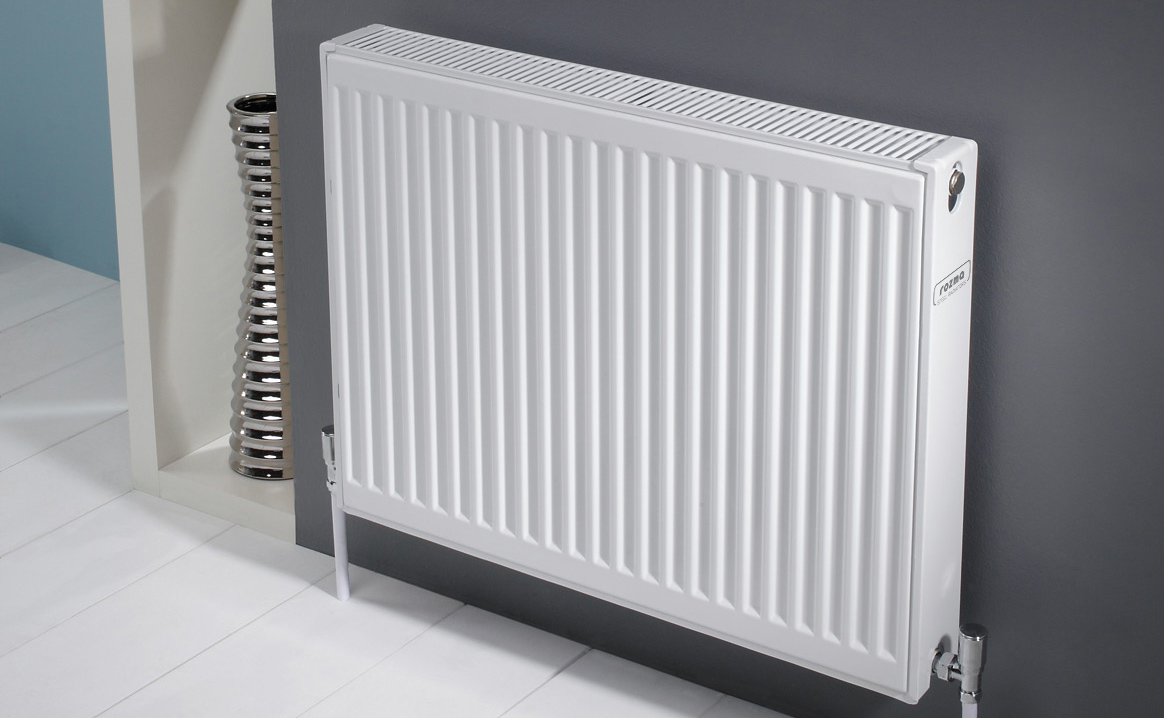
Differ reliability and longevity.
One of the types of metal batteries used to heat residential premises are steel radiators of heating - reliable, durable, made from a sheet of solid steel. From cast iron, they have a high heating rate, lower weight and affordable cost. In Russia, domestic manufacturers of convectors are popular, foreign ones are Finnish, German and Czech. It is worth to learn more about them in order to make right choice.
What is a steel radiator
According to construction information, a steel radiator is an appliance for heating a house. It consists of several sections, inside of which the coolant-water circulates. Radiators made of stainless steel are used in private houses and apartments. Material for them (low-carbon steel with increased resistance to corrosion) is flexible, ductile, durable and ductile. It can easily be welded and conducts heat. The sale of steel radiators is not uncommon, products are bought often, because they are budget.
Steel panel radiators
One type of heating devices are steel panel radiators. In the center of the products there are from one to three panels of rectangular shape, consisting of two flat profiles - sheets of stainless steel. On the elements of punching technology, grooves are placed, which, when welding, form channels-contours, through which water circulates. The metal heats up and gives its temperature to the surrounding air.
Several plate-shaped heating panels, connected together by nozzles, form a bag, close on the sides and on top with decorative strips or casings. To increase heat transfer to their back side, ribs are welded with a structure reminiscent of the P. on the photo. For such ribs, a thinner steel is used, which contributes to an increase in the heat output.
Steel tubular heating radiators
The second subtype is tubular steel radiators. Outwardly they are pipes welded together - a core and a body. Unlike the panel, the tubular convector is more complicated in performance, it costs more, can have different colors, looks stylish, is more resistant to pressure drops and ruptures. The most common is the classical version - the device is similar to cast iron, but inside it has more channels for the coolant. Apply tubular products to create a beautiful interior and design.
Characteristics of steel radiators
To facilitate the selection of heating appliances, pay attention to the characteristics of steel radiators of heating of the most popular firms among Russian buyers. You can buy them in online stores, the usual building departments or order by mail with delivery to your home. The cost depends on the type of convector, the manufacturer, the number of panels and heat transfer. Most brands offer panel convectors as the most budgetary ones. Steel radiators in bulk can be bought cheaply, many stores hold promotions with discounts and sales.
Steel radiators Purmo
Popular for purchase for heating private houses are Finnish steel radiators Purmo heating:
- model name: Purmo Compact 22 500 1000;
- price: 4000 rubles;
- characteristics: heat output 1470 W, dimensions 102/1000/500 cm, weight 28 kg, volume 5.5 liters, pressure up to 10 bar;
- pluses: maximum heating up to 110 degrees, two-panel, side connection, installed on the wall;
- cons: not detected.
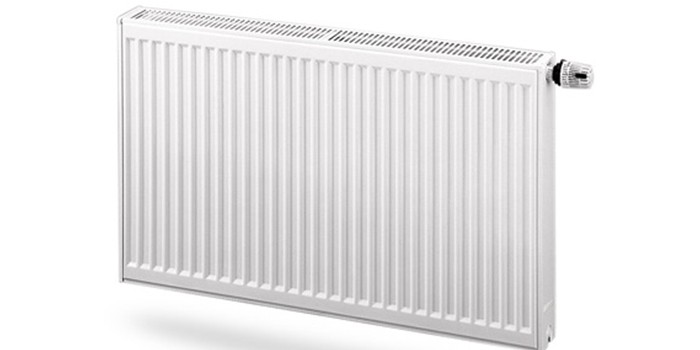
More affordable product with low cost from the same technical manufacturer is a one-pane:
- model name: Purmo Compact 11 500 1000;
- price: 2400 rubles;
- characteristics: 60/1000/450 cm, 15,5 kg, lateral connection, volume 2,7 l, wall-mounted;
- pluses: maximum working temperature 110 degrees
- minuses: low heat output 868 W,
- model name: Purmo Compact 22 500 1600;
- price: 5800 rubles;
- characteristics: two-panel, side-mounted, 102/1600/500 cm;
- pluses: high heat output of 2352 W, rugged housing;
- cons: large volume of 9 liters, weight 44.3 kg.
Steel radiators Buderus
Increased cost and proven quality are distinguished by the German steel heating radiators Buderus:
- model name: Buderus Logatrend VK-Profil 22 500 1000;
- price: 5000 rubles;
- characteristics: 100/1000/500 cm, 28 kg, the volume of 6.3 liters;
- pluses: high heat output 1826 W, heats 18 cubic meters, maximum temperature 120 degrees;
- cons: bottom mounting.

Next in popularity from the same brand is a product with similar parameters, but the advantage in the form of a side connection:
- model name: Buderus Logatrend K-Profil 22 500 1000;
- price: 4300 rubles;
- characteristics: lateral mounting, 100/1000/500 cm;
- pluses: high heat output 1826 W, operating temperature 120 degrees, pressure - up to 10 bar;
- cons: large weight 28 kg.
- model name: Buderus Logatrend VK-Profil 11 500 1000;
- price: 3200 rubles;
- characteristics: heats 10 cubic meters, temperature - 120 degrees, 65/1000/500 cm;
- pluses: a small volume of 3.2 liters, weight 15 kg;
- cons: floor mounting (part of the heat goes away), a small heat output of 990 watts.
Steel radiators Prado
Particularly popular are the Russian steel radiators Prado heating, because they represent a combination of quality and affordable value:
- model name: Prado Classic 20 500 1100;
- price: 4200 rubles;
- characteristics: operating temperature - 120 degrees,
- pluses: lateral installation, heat output - 1181 W, volume - 6.2 l, 84/1100/500 cm;
- minuses: low working pressure up to 9 bar, high weight 22.5 kg.
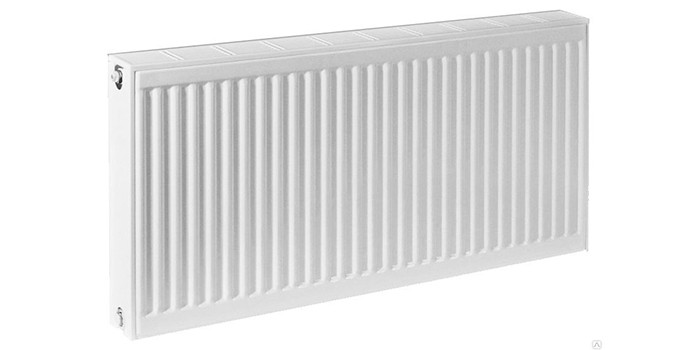
The second most popular option is a classic product with a shorter length and affordable price:
- model name: Prado Classic 20 500 900;
- price: 3300 rubles;
- characteristics: lateral mounting, 84/900/500 cm, two-pane;
- pluses: small volume of 5 liters, low weight (19 kg);
- minuses: a small heat output of 965 W, pressure - up to 9 bar.
The following version of the same manufacturer is considered more subtle than the first devices:
- model name: Prado Classic 10 300 1100;
- price: 2700 rubles;
- characteristics: 48/300/1100 cm, two-pane, side mounting;
- advantages: 5 years guarantee, low weight (7.7 kg), small volume 2 liters;
- cons: a small power of 573 watts.
Steel radiators of heating Korado
Known for their quality Czech steel radiators Korado, which are expensive and made of reliable material:
- model name: Korado RADIK KLASIK 21 400 1600;
- price: 5500 rubles;
- characteristics: wall, side mounting, two-panel, 66/1600/400 cm;
- pluses: high heat output (1500 W), small volume 7 l, heating up to 110 degrees;
- cons: heats 15 cubic meters, weight 30 kg.
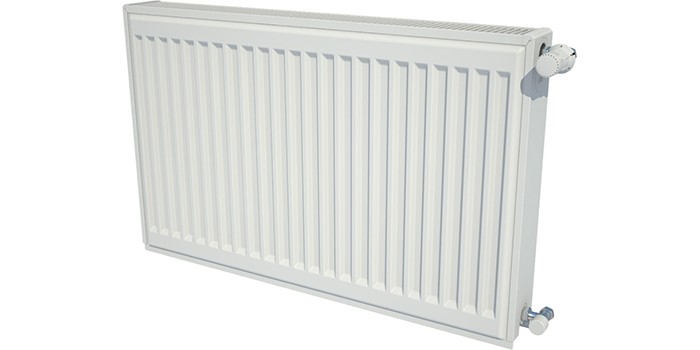
The next option, offered by the same manufacturer, differs in cost in the smaller side due to the reduced sizes:
- model name: Korado RADIK KLASIK 20 600 1600;
- price: 5000 rubles;
- characteristics: wall, side connection, 66/1600/600 cm;
- pluses: high heat output 1564 W, temperature 110 degrees;
- cons: heats 10.5 cubic meters, the volume of 9.5 liters, weight 39 kg.
Even lower in cost is a variant from one panel, heating only four cubic meters, but for small apartments it will become a find:
- model name: Korado RADIK VK 11 500 500;
- price: 2900 rubles;
- characteristics: single-panel, wall-mounted, 63/500/500 cm;
- pluses: heating up to 110 degrees, a small volume of 1.5 liters;
- cons: lower connection, heats 4 cubic meters, heat output 429 W.
Steel heating radiators Kermi
The market is known for German steel panel radiators of Kermi heating, as average in value and products with great advantages:
- model name: Kermi FTV (FKV) 11 500 1000;
- price: 3600 rubles;
- characteristics: single-panel, wall-mounted, 59/1000/500 cm, 16 kg;
- plus: heat output 1147 W, heats 11 cubic meters, volume 2.7 liters;
- cons: bottom connection
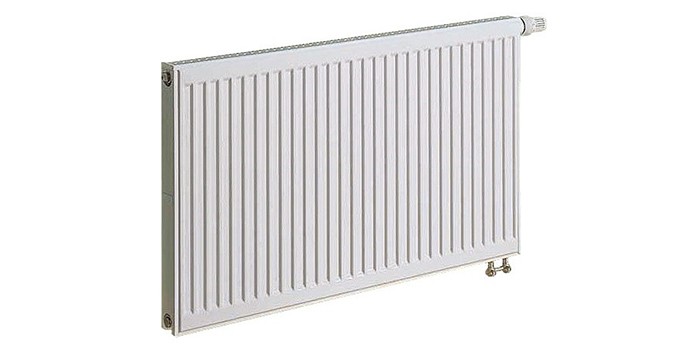
Among the German steel convectors heating Kermi popular is the following convector:
- model name: Kermi FTV (FKV) 22 500 1000;
- price: 5200 rubles;
- characteristics: wall, volume 5,5 l, two-pane, 100/1000/500 cm, 29 kg;
- pluses: heats 19 cubic meters, high heat output 1930 W;
- cons: bottom connection (heated floor, there is a loss of heat).
- model name: Kermi FKO 22 500 1000;
- price: 4400 rubles;
- characteristics: wall, side connection, volume 5.5 l, 100/1000/500 cm, 29 kg;
- pluses: high heat output of 1930 W, heated to 110 degrees;
- cons: no shortcomings.
How to choose a steel radiator
To ensure that your choice of a steel radiator does not upset the unpleasant consequences, it is worthwhile to listen to the advice of builders and buy products, following the criteria:
- Heat output - the more it is, the faster the room warms up. There are convectors with 1200-1800 W.
- Convection - instruments can emit heat themselves or transmit it by convection. The latter is accompanied by the formation of a large amount of dust, so it is not suitable for children and allergy sufferers.
- Working pressure - normally should be 6-10 for panel and 8-15 for tubular. Steel products can not be used in a centralized heating system - there will be gaps. Choose them only for a private house.
- Quality of the heat carrier - water is used, therefore the channels for efficiency must be covered with anticorrosive substances.
- Connection - it is better to choose lateral or vertical, because the lower one turns into losses of heat due to lowering the height and embedding in the floor.
- Dimensions - depending on the size of the walls, where they are installed. The larger the width of the product, the slower it will be, the more frequent air congestion will be formed.
- The thickness of steel - for operation the thicker, the better. Optimum to choose 1,15-1,25 mm.
